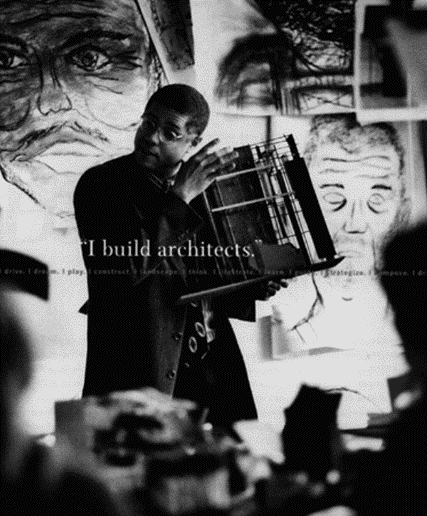(L.) Design-Build Weather Station (experimental test structure) with Participating Students, Industry Partner, and local Community Members, Tanzania, Africa, and (R.) Fabricating the Project’s Wooden Trusses
“As an Architect, you design for the present with an awareness of the past for a future which is essentially unknown.” – Norman Foster
As a university educator, Professor Fowler creates innovative design studios, enriched academic experiences, multi-disciplinary collaborations with other university departments, and critical links between the academy and professional practice. The importance of architecture students understanding the role of storytelling, having the agility to fit into a collaborative project at any point of entry, and being able to use their acquired skills in contributing to the larger aspirations as set by the team are all skills that successful architects need to practice.
Many of Fowler’s colleagues, over the years, have best summed up his unique contributions to his creative environment for teaching/learning about the practice of architecture.
From colleagues on teaching environments:
Thomas Fowler genuinely cares not only about the depth and breadth of his students’ architectural education but also about their character and ethics. He shows his students how they can positively influence and support the society they will inherit and leads through quiet but salient example.
—Roberta W. Jorgensen, FAIA, LEED AP Communitas Architects, Inc.
Our architecture department is a pretty special place where teaching is excellent, inspired, and also … a bit magical. It has a secret sauce, and Tom is an essential ingredient.
—Christine Theodoropoulos, Dean of Cal Poly College of Architecture and Environmental Design
Reflexive excepts from former students / successfully practicing architects:
Tom’s interdisciplinary studio approach enabled us to experience a diversity of collaborative projects to use our collective skills to achieve a common goal.
—Snehal Daliya, Designer Fergus Garber Young Architects,
Professor Fowler can tiptoe the fine line between constructive candor and grasping reality as an educator, preparing his students for the evolving tug o’ war of the design process.
— Jonas Houston, PE, Senior Engineer, Holmes Structures
Thomas Fowler’s personal integrity and commitment to excellence in educating future generations of architects is an asset to our profession and discipline.
—Dominic Leong, Founding Partner Leong Leong,
With Tom’s guidance, I was able to develop a unique industry 5th-year thesis which built on my previous professional experience (from Tom’s SOM program) that led directly to the career I have today.
—Sarah Jester, AIA, Senior Architect, SOM, Shanghai, China
Fifteen years later, I remember Tom’s words of encouragement and mentorship clearly – “Suspend your disbelief!” – and I find myself continually passing them along to the team of designers I now lead.
—Frank E. Mahan, AIA Principal at Skidmore, Owings & Merrill (SOM) + Adaptive Reuse Practice Leader
Thomas Fowler has shaped and touched my career and life path in the most extraordinary positive ways; his key guidance and deeply inspiring learning environment of his studio continue to resonate in my career as a teacher and practitioner.
— Adriana Cuellar, Founding Principle CRO Studio, Tijuana, Mexico/San Diego, CA
Tom’s vision as an educator and his selfless dedication to architecture as a craft have continually inspired me to seek deeper explorations of design.
—Hugo Martinez, Founder, and Principal Designer MAT-TER Design Build Studio
Fowler’s teaching practice career has expanded over four decades. And has taught a range of design studios (both undergraduate: 3rd, 4th, and 5th-year independent study studios and multidisciplinary graduate building design studios) and professional practice courses along with working as co-founder with his structural engineering colleague, the Design Collaboratory, on multidisciplinary student/faculty and with industry partners on varied scaled design-build projects. Fowler has successfully created a unique opportunity for students to work and obtain internship credit along with academic design studio credit inside the office of Skidmore Owings and Merrill (SOM), San Francisco, CA. Students directly work with the architects and engineers in this office and obtain the opportunity to work on high-rise projects for academic credit and on a range of other projects for internship experience.
He also created a multi-disciplinary academic design studio which provided the opportunity for SOM to work with students in the academic setting of the university on the design of a skyscraper project. Fowler has observed over the years that the levels of student motivation in a design studio and the quality of work and levels of experimentation go through the roof and are so much stronger when academic design projects are framed with real-world constraints.
In Fowler’s recent forward to Pressman’s latest edition of Professional Practice 101, he highlighted the important linkages of framing the ethical, social responsibilities of design firms in the academic environment, which does support very well the teaching of future architects, along with Sharon Matthews’ essay where she frames an understanding of the role of the design process which was for her the equivalent to leaning a magical spell for understanding the journey of the challenges to understanding the building design process and the late prominent structural engineer (a vital role for successful projects, but, typically a hidden hero of significant works of architecture) Mario Salvador’s “Daring Piece of Advice to Young Architects”… “encouraging the giving of all of your enthusiasm, your belief in your dreams and your patience to design architecture the way you believe architecture should be designed,” is refreshing and motivating to hear.
A range of images of Fowler’s creative design studio environment.

Images of Fowler’s Creative Design Studio Environment

1997 IBM’s Annual Report, Represented the California State University System (23 campuses), Selected in Recognition of Effective, Innovative Methods for Integrating Advanced Technology into the Design Studio Building Process
Brief Bio
Thomas Fowler IV, FAIA, is a Distinguished Professor of the ACSA and of Cal Poly State University, San Luis Obispo, California, where he currently teaches, along with being the Director of the Graduate Architecture Program. He has over 20 years of professional practice experience as an architect and over 30 years of teaching in both the undergraduate architecture design studios and co-teaching (with a structural engineer) in the interdisciplinary graduate building design studios.
In recognition of Professor Fowler’s innovative teaching and collaborative community work, he was elevated to Fellowship in the American Institute of Architects (AIA) in 2019, granted to only 3% of the professional membership; received the prestigious Cal State University (CSU) Wang Teaching Award in 2019, selected from all 23 CSU campuses; along with selection twice by Design Intelligence as one of the 25 most admired Educators in the USA. His students have been recognized for their work in a range of national and international design competitions.
He is the co-founder of the Design Collaboratory (started with his structural engineering partner) and has been a board member of the non-profit NGO called the Mbesese Initiative for Sustainable Development since 2015, located in the Kilimanjaro Region of Tanzania, Africa, in a city called Same (Saa – May). Mbesese was developed to assist this local community in a range of community projects that have included the design and construction of a steel bridge for local school children, faculty, and staff to have safe access during the torrential rainy season, along with the ongoing multi-year development of a master plan and building designs for a new Polytechnic Campus which will have a market and other social spaces for learning and social interaction between the campus and the community.
Additional work of the Design Collaboratory includes a range of community projects where this multi-disciplinary team works directly with a client who has an idea for a project, and our multidisciplinary team of students, faculty, and industry partners (engineers, architects, etc.) works to design, fabricate and build the project. A highlighted example of this is the Center for Centering (C4C) Pavilion. Designed as a portable meditation space, using the foundational principles of circularity, reusing, repairing, and prototyping for remanufacturing were the key concepts behind the design of the flat packable dome. The 16’ diameter/height of the wooden structure was designed with the idea of ease of assembly/disassembly made with friction-fit components that can be transported via van and takes four persons and almost 4 hours to assemble and half-this-time to disassemble.
C4C Structure

Sourced photo
As an author, he has contributed chapters to several publications: selected highlights include: Professional Practice 101, A Compendium of Effective Business Strategies in Architecture, 3rd edition (2020), Pressman, A Teachers View, by Thomas Fowler IV: Becoming an Architect (Guide to Careers in Design), 1st, 2nd and 3rd Editions, Lee Waldrep, in collaboration w/ collaborative partner, 2020 Skyscraper Collaboratory An Interdisciplinary Architecture and Structural Engineering Design Studio Collaboration with Industry Partner, Skidmore, Owings and Merrill (SOM), Architecture, Structures and Construction, International Conference of Structures and Architecture, and Collaborations in Architecture and Engineering; With multiple collaborators, Collaborations in Architecture and Engineering, Olsen, McNamara.









